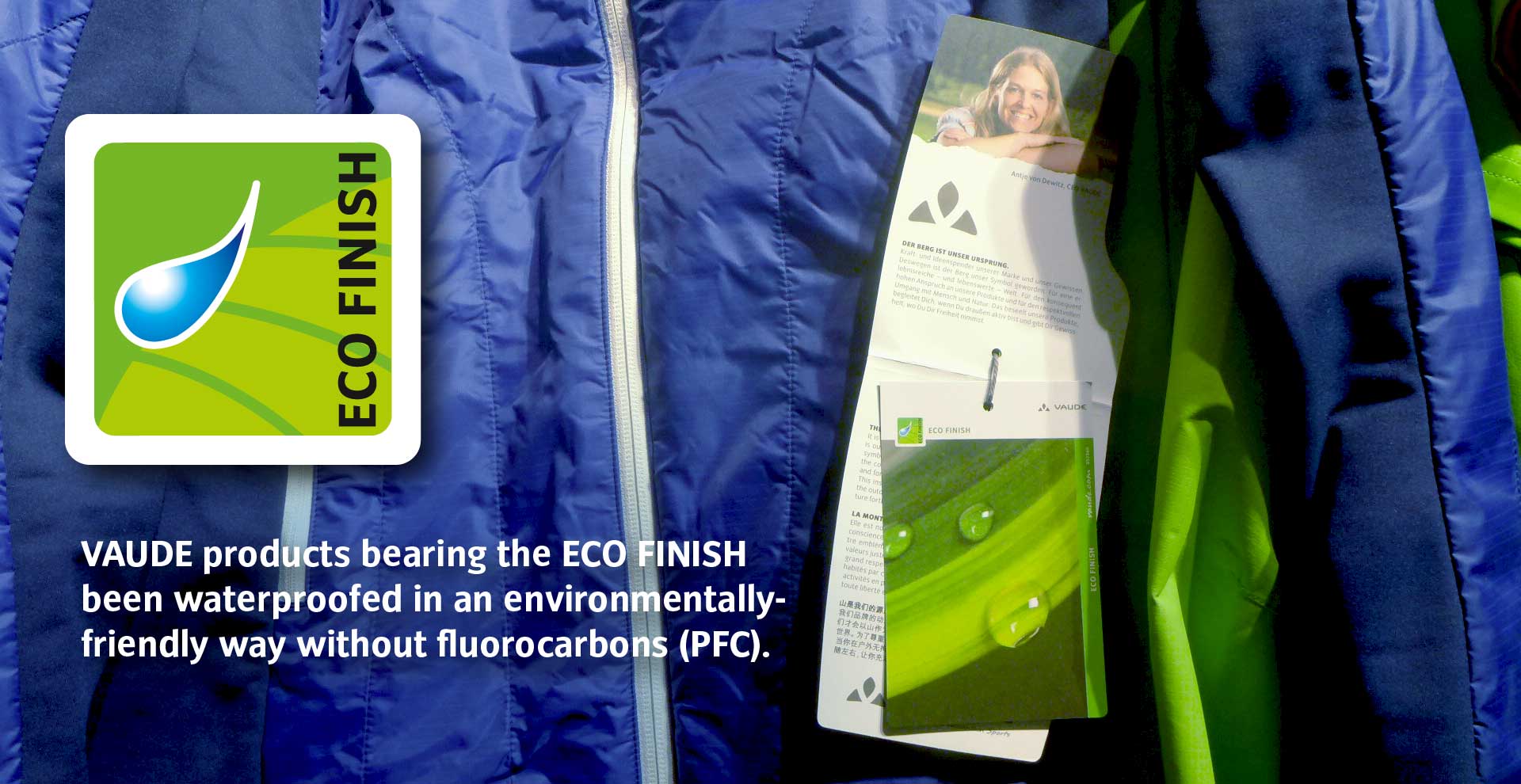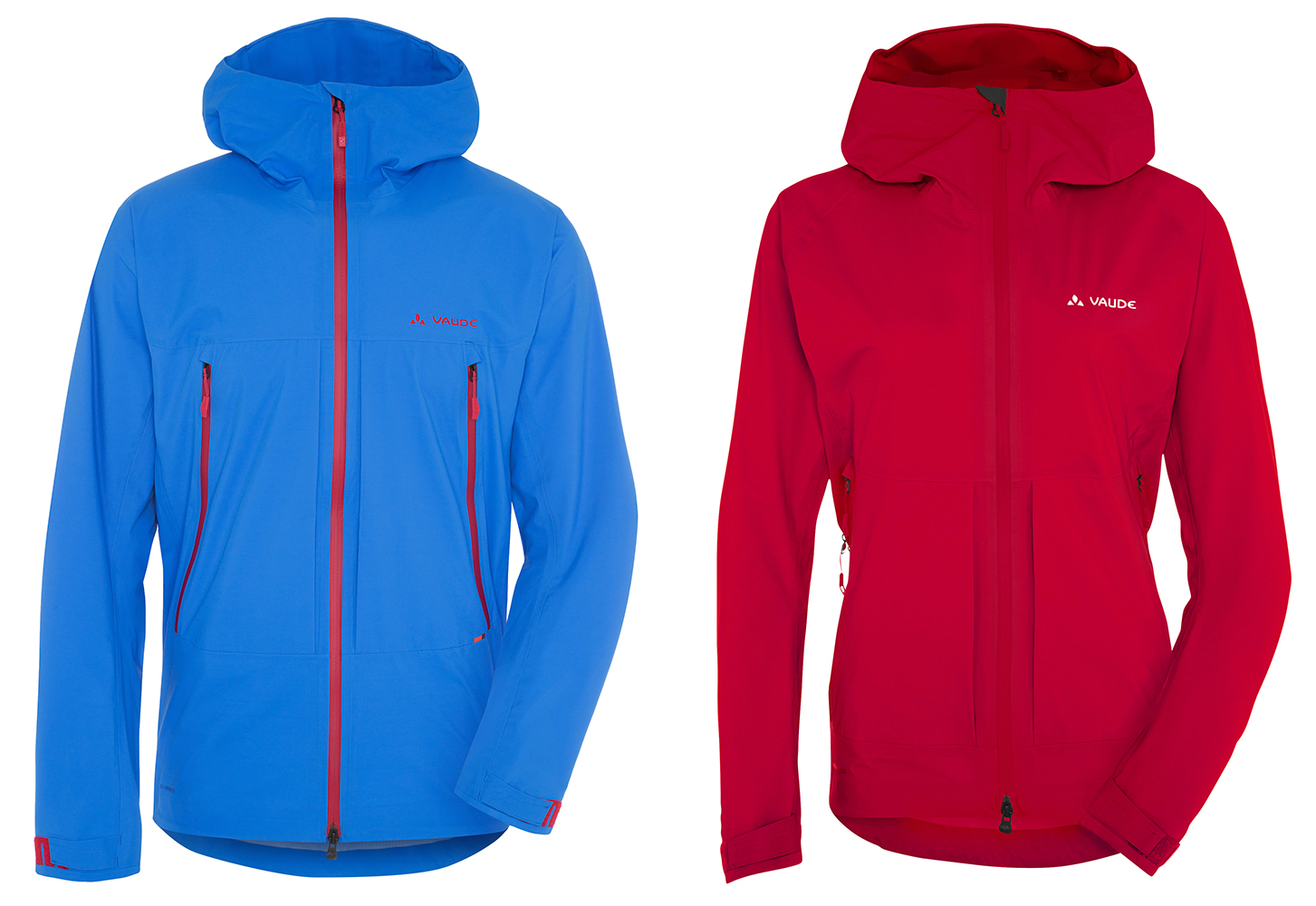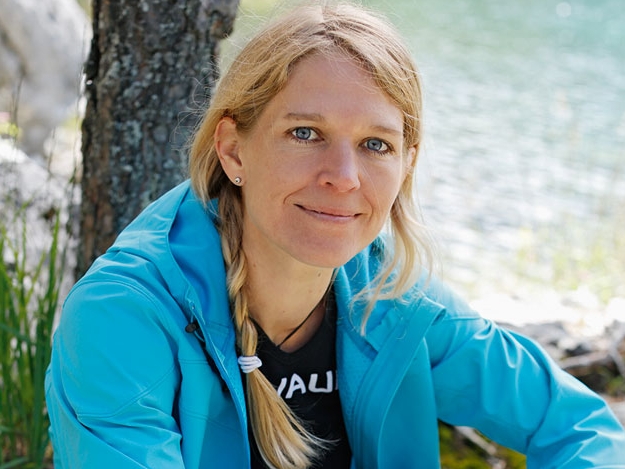
Strategy against excessive chemicals
Balance between "Performance" and "Ecology"
Outdoor products are so popular precisely because of their water and dirt-repellent properties. This functionality can be achieved with the help of chemical substances.
Until now, poly- and perfluorinated chemicals (PFCs or fluorocarbons) have been the star players in waterproofing. PFCs are used on the surface of outdoor clothing, backpacks, sleeping bags, tents and shoes to allow water and dirt to run off these products.
Open communication on PFCs
Poly- and perfluorinated chemicals (PFCs or fluorocarbons) have long been known as a critical issue in outdoor products. The "Detox" campaign from the environmental organization Greenpeace has also made this a hotly debated topic in public. Open communication about it is very important to us.
PFC-free thanks to VAUDE Eco Finish
VAUDE has long worked proactively toward the full elimination of fluorocarbon use. On the one hand, VAUDE has been exclusively using PTFE-free membranes for years. On the other, we are working hard to try to find functional PFC-free alternatives and gradually convert the entire collection. The decisive criterion is "Durable Water Repellency" (DWR).
In our webshop, we have a dedicated filter to help our customers easily find PFC-free products.

VAUDE fully eliminates the use of PFCs
Waterproofing is a must: Durable Water Repellency (DWR) is a finish on textile surfaces to repel water. Without this surface treatment, the outer fabric would soak up rainwater, which leads to a clammy, wet feeling for the wearer, despite the waterproof membrane.
VAUDE has voluntarily agreed to become fully PFC-free across the entire collection no later than 2020, apparel until 2018.
95% of our apparel products are PFC-free
Our VAUDE materials team is testing material by material, product by product to find PFC-free DWRs that achieve good results in terms of functionality. This is a long and laborious process that we are forging ahead on together with the manufacturers of materials and DWR chemicals as well as experts from universities and associations.
We are proud that we have now been converted many of our materials to PFC-free DWR. Products that do not need DWR (such as shirts or underwear) have always, of course, been PFC-free.
The proportion of all PFC-free apparel products (i.e. products without DWR and products with Eco-Finish waterproofing) is 95% for the Summer Collection 2017. We were able to increase the proportion of all waterproof and water-repellent clothing products (i.e. all products with DWR) in the Summer Collection 2017 by 37% compared to the Summer Collection 2016.
Starting in Summer 2016, we are bringing shoes with Eco Finish to the market; sleeping bags already have a 100% PFC-free finish.
Percent of Eco Finish (PFC-free) for waterproof and water repellent products per season and product area
Create your own infographicsGreener Alternatives

For all VAUDE products the VAUDE Manufacturing Restricted Substance List (MRSL) applies which includes strict usage bans and limits for PFC.
Also, the bluesign® System strictly limits the usage of PFC.
Despite the high energy we're using to phase out the use of PFCs, we still have some waterproof products with C6-PFC technology in our product range. We are working diligently on the full elimination of PFCs.
In the news section of this sustainability report, as well as in the Detox chapter we are continuously updating the presentation of our progress (or setbacks).
PTFE-free membrane
In addition to waterproofing, PFCs are also needed as an additive for the production of polytetrafluoroethylene (PTFE) membranes. Above all, the concern is perfluorooctanoic acid (PFOA, more info below) which is a persistent and bioaccumulative organic substance that is suspected of being carcinogenic. In addition, when disposing of textiles with PTFE membranes without expensive special treatments, toxic fluorine compounds can be released into the environment, typically as hydrofluoric-acid and perfluorocarbons.
Years ago, we made a clear decision to eliminate the use of PTFE membranes in all products, the production of which requires PFC. Since that time, we have only used PTFE-free membranes.
Our alternatives:
- Sympatex®: from polyether (PE). This hydrophilic, non-porous membrane is extremely flexible, very thin and offers excellent wind and water resistance. It can be 100% PTFE-free, is made from recycled polyester and is biodegradable without leaving toxic degradation products. The Sympatex membrane is bluesign® approved.
- Ceplex: our time tested, in-house membrane comes in three different performance levels (active, advanced, pro), is made of polyurethane and is 100% fluorocarbon-free.
Special case Polartec® Neoshell
In the 3-layer, men’s and women’s Goliath Jacket (which will be launched for Winter 2016), a highly functional Polartec® Neoshell membrane was used. Although this is PTFE-free, we did find that it still contained small amounts of PFC (C6). For the production of the Goliath Jacket, this finding came too late – production was already running.
All other models originally planned with this material were immediately stopped; we have decided to no longer use this material in the collection. Our supplier could not tell us why PFCs were needed in the Neoshell membrane.
Despite the high costs associated with the cancellation of the remaining models and the increased expenditure in product development, for VAUDE, membranes with PFC are unacceptable.
C6 as a provisional technology
C6 DWR is seen as an environmentally friendly alternative to C8 DWR. It contains only six carbon atoms, and cannot form PFOA. However, C6 chemicals spread even faster through the global waterways than C8, and it is more difficult filter out of drinking water, for example.

CEO Antje von Dewitz about this topic:
»Starting with the Clothing Collection Summer 2014, VAUDE uses PFOA-free DWR exclusively. All water resistant products are completely PFC-free since the summer 2015 collection. Those are labelled with the VAUDE Eco Finish hangtag. In waterproof products, VAUDE has replaced the C8-DWR with C6-DWR as a first step, because the PFC-free DWR unfortunately do not perform sufficiently yet. We see this only as a bridging technology, that is, as an intermediate step on the way to a complete phase-out of PFC. This is our goal.«
VAUDE is working on the complete elimination of fluorocarbons and is gradually converting the entire collection. This should be implemented by 2020 at the latest.
The challenge for us as a manufacturer is to find the right balance between "performance" and "ecology". The decisive factor here is also the awareness and attitude of our customers, and the extent to which they are willing to forego the usual functionalities of products on behalf of the environment.
Detected traces of PFOA even in Antarctica
The most criticized substance is called PFOA (perfluorooctanoic acid). This substance does not naturally exist in nature, but has now been detected around the world, even in the Antarctic. Traces of PFOA can also be found in finished products such as in jackets.
PFOA is produced in the manufacturing process based DWR based C8 technology. C8 represents eight carbon atoms. It is also believed that an important raw material for the production of C8 manufacturing, fluortelomer alcohol (FTOH) decomposes in the environment into PFOA.
PFOA is therefore considered an especially dangerous PBT-substance:
- P = persistent: does not degrade
- B = bio-accumulative: accumulates in the body
- T = toxic: is poisonous
The EU is considering a ban on perfluorooctanoic acid (PFOA), but so far, there's only a legal limit in Norway.
Through the food chain into organisms
For the users of outdoor products made with PFCs., there are no risks based on current knowledge. However, in the manufacturing process in production countries, in the subsequent washing of the finished product as well as the product disposal, PFC substances pose a risk to people and the environment. They accumulate in the environment and in the human body through the food chain and are not biodegradable.
Video published: 2nd November 2012
| GRI: | G4-PR6 |






